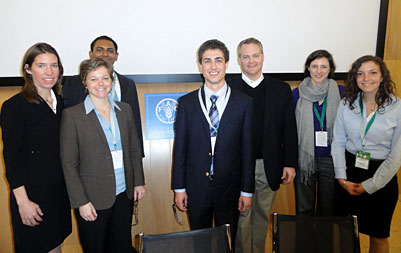Student/faculty team stresses value of in-country food aid purchases at Rome meeting
By Krishna Ramanujan

Five Cornell students and one faculty member recently made presentations at a major international food aid meeting in Rome that have people in Washington and elsewhere in the world taking notice.
At the Food and Agriculture Organization's (FAO) International Scientific Symposium on Food and Nutrition Security Jan. 18, the Cornell team presented findings in support of Congressional reauthorization of a rapidly growing food assistance approach that would allow U.S. private voluntary organizations (PVOs) to continue to purchase food aid commodities within the country where it is to be distributed or in a nearby country, as opposed to buying it in and shipping it from the United States.
According to the Cornell team's research, outlined in a 200-page report, chapters of which are now under peer review for a special section of a prominent journal, this approach, called local and regional procurement (LRP), is a far quicker food source compared with shipping food from the United States. It is also more cost effective for low-value-to-weight commodities, such as bulk grains and pulses.
But, U.S. purchases of more processed products such as vegetable oil and corn-soy blends were more cost-efficient than buying locally. In most cases, the researchers found that LRP did not affect market prices or price volatility and that while food aid recipients were satisfied with their products regardless of origin, they were even further satisfied by locally procured foods.
"Our presentations are already drawing some attention, as we argued that Congress needs to continue and expand LRP," said Chris Barrett, the Stephen B. and Janice G. Ashley Professor of Applied Economics and Management, who led the research with assistant professor Miguel Gomez, both in Cornell's Charles H. Dyson School of Applied Economics and Management, and Erin Lentz, a resource support specialist in the Dyson School and a doctoral student in the field of sociology.
"This research has never been done before; it fills a void in policy debates and it's already being picked up in Washington and in Rome," he added.
In 2010, 67 percent of global food aid used LRP, up from 11 percent in 1999. The growth stems partly from the United States coming on board with LRPs for the first time in 2008; Canada and the European Union had increasingly used LRPs for a number of years prior.
The 2008 U.S. Farm Bill authorized $60 million for LRP via the U.S. Department of Agriculture (USDA) through 2012, and a supplemental appropriations act also authorized the U.S. Agency for International Development to buy food aid locally in emergencies. Now, Congress is discussing whether to reauthorize funds for LRP.
After the USDA began soliciting LRP proposals from PVOs in 2008, four PVOs -- Catholic Relief Services, Land O'Lakes, Mercy Corps and World Vision -- approached Barrett and colleagues to establish a monitoring and evaluation system and to analyze the resulting data. The Cornell researchers examined six distinct objectives in nine countries -- Kenya, Uganda, Burkina Faso, Niger, Mali, Zambia, Guatemala, Kyrgyzstan and Bangladesh -- where the four PVOs piloted LRP projects.
In a session dedicated to the Cornell findings and chaired by Barrett, five students presented their research.
Students working on the project included Will Violette '12 and Simone Passarelli '12 and graduate students Lentz, Teevrat Garg, Aurelie Harou and Joanna Upton.
The Ashley Professorship supported the students' time on the project and their travel to Rome.
Media Contact
Get Cornell news delivered right to your inbox.
Subscribe